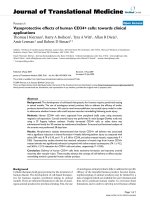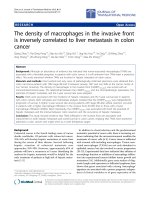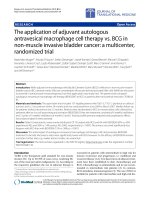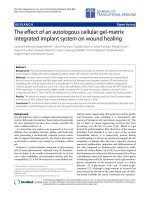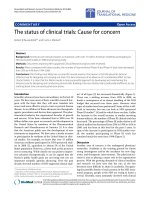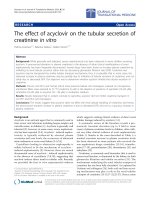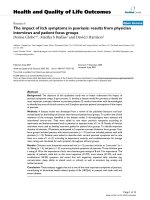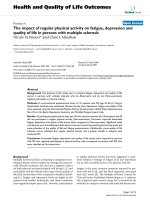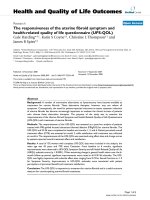báo cáo hóa học: " The effects of high frequency subthalamic stimulation on balance performance and fear of falling in patients with Parkinson''''s disease" docx
Bạn đang xem bản rút gọn của tài liệu. Xem và tải ngay bản đầy đủ của tài liệu tại đây (305.52 KB, 10 trang )
BioMed Central
Page 1 of 10
(page number not for citation purposes)
Journal of NeuroEngineering and
Rehabilitation
Open Access
Research
The effects of high frequency subthalamic stimulation on balance
performance and fear of falling in patients with Parkinson's disease
Maria H Nilsson*
1,2
, Per-Anders Fransson
3
, Gun-Britt Jarnlo
1
,
Måns Magnusson
3
and Stig Rehncrona
2
Address:
1
Department of Health Sciences, Division of Physiotherapy, Lund University, Lund, Sweden,
2
Department of Neurosurgery, Clinical
Sciences, Lund. Lund University Hospital, Lund, Sweden and
3
Department of Otorhinolaryngology Head and Neck surgery, Clinical Sciences,
Lund, Sweden
Email: Maria H Nilsson* - ; Per-Anders Fransson - ; Gun-Britt Jarnlo - Gun-
; Måns Magnusson - ; Stig Rehncrona -
* Corresponding author
Abstract
Background: Balance impairment is one of the most distressing symptoms in Parkinson's disease
(PD) even with pharmacological treatment (levodopa). A complementary treatment is high
frequency stimulation in the subthalamic nucleus (STN). Whether STN stimulation improves
postural control is under debate. The aim of this study was to explore the effects of STN
stimulation alone on balance performance as assessed with clinical performance tests, subjective
ratings of fear of falling and posturography.
Methods: Ten patients (median age 66, range 59–69 years) with bilateral STN stimulation for a
minimum of one year, had their anti-PD medications withdrawn overnight. Assessments were done
both with the STN stimulation turned OFF and ON (start randomized). In both test conditions, the
following were assessed: motor symptoms (descriptive purposes), clinical performance tests, fear
of falling ratings, and posturography with and without vibratory proprioceptive disturbance.
Results: STN stimulation alone significantly (p = 0.002) increased the scores of the Berg balance
scale, and the median increase was 6 points. The results of all timed performance tests, except for
sharpened Romberg, were significantly (p ≤ 0.016) improved. The patients rated their fear of falling
as less severe, and the total score of the Falls-Efficacy Scale(S) increased (p = 0.002) in median with
54 points. All patients completed posturography when the STN stimulation was turned ON, but
three patients were unable to do so when it was turned OFF. The seven patients with complete
data showed no statistical significant difference (p values ≥ 0.109) in torque variance values when
comparing the two test situations. This applied both during quiet stance and during the periods with
vibratory stimulation, and it was irrespective of visual input and sway direction.
Conclusion: In this sample, STN stimulation alone significantly improved the results of the clinical
performance tests that mimic activities in daily living. This improvement was further supported by
the patients' ratings of fear of falling, which were less severe with the STN stimulation turned ON.
Posturography could not be performed by three out of the ten patients when the stimulation was
turned OFF. The posturography results of the seven patients with complete data showed no
significant differences due to STN stimulation.
Published: 30 April 2009
Journal of NeuroEngineering and Rehabilitation 2009, 6:13 doi:10.1186/1743-0003-6-13
Received: 4 April 2008
Accepted: 30 April 2009
This article is available from: />© 2009 Nilsson et al; licensee BioMed Central Ltd.
This is an Open Access article distributed under the terms of the Creative Commons Attribution License ( />),
which permits unrestricted use, distribution, and reproduction in any medium, provided the original work is properly cited.
Journal of NeuroEngineering and Rehabilitation 2009, 6:13 />Page 2 of 10
(page number not for citation purposes)
Background
Postural instability is one of the cardinal symptoms of
Parkinson's disease (PD), and persons with PD run an
increased risk of falling [1,2]. Most falls occur during func-
tional activities, e.g. walking and turning [3], and it is
common to experience near falls and a fear of falling
[2,4,5]. Contributing factors to falls are numerous and
affect both voluntary and reflexive movements in persons
with PD. For instance, persons with PD have mobility dif-
ficulties, postural inflexibility, axial stiffness and deficits
in central proprioceptive integration [6]. Balance capacity
is a prerequisite for most of our daily tasks, and balance
impairment has been shown to be one of the most dis-
tressing symptoms for patients with PD [7]. The balance
impairment remains a limitation despite the use of phar-
macological treatment [8] and levodopa has been shown
to increase postural sway [9].
High frequency deep brain stimulation (DBS) in the sub-
thalamic nucleus (STN) was introduced as a complement
to pharmacological treatment for patients with severe PD.
STN stimulation provides a more constant therapy
throughout the day, and has been shown to reduce motor
symptoms, motor fluctuations and decrease PD-medica-
tion requirements [10,11]. Whether STN stimulation can
improve postural control is under debate [12]. The effect
of STN stimulation alone can be studied after overnight
withdrawal of anti-PD medication and by turning the
stimulation OFF and ON respectively. STN stimulation
alone has been shown to improve the results of the Berg
Balance Scale (BBS) [13] and the postural stability test
(item 30) of the Unified Parkinson's Disease Rating Scale
(UPDRS) [10,11,14]. Item 30 (postural stability) of the
UPDRS is the most commonly used clinical test for
patients with PD that includes an external perturbation.
The instructions and standardization of this item has been
criticized in several studies, which is highlighted in a
review article by Grimbergen et al.[6]. In comparison,
posturography tests have the advantages of allowing a
standardized and reproducible procedure of using exter-
nal balance perturbations and a quantification of the pos-
tural responses.
Posturographic studies have shown that STN stimulation
improves postural control, although Maurer et al. found
that it hardly affected the patients' deficits in response to
destabilizing visual tilts [9,15-17]. In some cases, assess-
ment of quiet stance on a firm surface lacks the sensitivity
to distinguish healthy subjects from patients with balance
disorders [18]. A method commonly used to increase the
sensitivity to detect balance deficits with posturography is
to study the stability while postural control is challenged
by balance perturbation through the somatosensory sys-
tem using vibration of skeletal muscles or tendons [19].
Vibration applied to a muscle increases the afferent sig-
nals from the muscle spindles and creates a propriocep-
tive illusion that the vibrated muscle is being stretched
[20]. The tonic stretch reflexes consequently induced are
intended to return the vibrated muscle to its perceived
original length [21]. Vibration of the neck or calf muscles
often induces body movements primarily in an anterior-
posterior direction [22]. One advantage with vibratory
stimulation compared with balance perturbations meth-
ods that use physical movements, e.g., translation or incli-
nation of the supporting surface, is that the stimulus effect
is isolated to a single sensory input, i.e., the propriocep-
tion. Another advantage is that a vibratory stimulation
can be controlled to produce a well-defined stimulation
over time with a broad effective frequency spectrum. In
none of the previous posturographic studies that investi-
gated the effect of STN stimulation [9,15-17] was vibra-
tory stimulation used on the calf muscles [23,24]. Persons
with PD fall during activities [3] when balance is chal-
lenged by self generated perturbations and not when chal-
lenged by external perturbations. Accordingly, it is
important to incorporate assessments that mimic activi-
ties of importance in daily living. When assessing balance
impairment in persons with PD, it has been recom-
mended to use an extended functional assessment of bal-
ance performance and a subjective assessment of fear of
falling [5,25-27].
To our knowledge, no previous study has investigated the
effect of STN stimulation alone by combining all of the
above aspects that may underpin balance impairment in
persons with PD. That is, combining an extended battery
of clinical performance tests, subjective ratings of fear of
falling and laboratory assessments that investigate reflex-
ive movements. The aim of the present study was to
explore the effects of STN stimulation alone on balance
performance as assessed with clinical performance tests,
subjective ratings of fear of falling and posturography.
Materials and methods
Patients
Ten patients (median age 66, range 59–69 years) with PD
were included in the study (Table 1). Inclusion criteria
were patients with PD between 59–69 years old who were
treated with bilateral STN stimulation for at least one year
in order to ensure a stable DBS treatment. All patients
were recruited from the Department of Neurosurgery,
Lund University Hospital, and the neurosurgical proce-
dure has been described elsewhere [13].
Twenty-five patients fulfilled (22 men, three women) the
inclusion criteria, but 14 patients were excluded due to the
following exclusion criteria: concomitant diseases inter-
fering with balance testing, an inability to cooperate or an
inability to stand for two minutes without support. One
patient declined participation.
Journal of NeuroEngineering and Rehabilitation 2009, 6:13 />Page 3 of 10
(page number not for citation purposes)
The ten included patients had all been followed up within
six months before the study start. A routine clinical neuro-
logical examination was then performed, and if needed
the DBS and medication was adjusted to optimize the
treatment effect. The local ethical committee, Lund Uni-
versity, approved the study and all patients gave their writ-
ten informed consent.
Procedure & assessments
The patients were assessed as inpatients. Demographic
data were collected at admission. The patients were asked
to estimate their fall incidence during the past six months,
and if they had experienced any near falls (for definitions
see Table 1). The Physical Activity Scale for the Elderly was
administered (Table 1), and this questionnaire has been
tested for validity and reliability in the elderly [28,29]. As
a pre-assessment trial, the physiotherapist (PT) assessed
the patients when they felt at their best with their regular
treatment, i.e. both anti-PD medication and STN stimula-
tion. One leg stance and sharpened Romberg were then
performed bilaterally in order to select the preferred leg
(with best results) for the tests on the following day.
In order to investigate the effect of STN stimulation alone,
all anti-PD medications were withdrawn overnight (from
10 pm). On the following morning, orthostatic blood
pressure was measured before an independent person
programmed the DBS to either ON or OFF. In order to
avoid any systematic differences and bias, there was a ran-
domization performed before the start of the study. Five
patients were randomized (sealed envelopes) to begin the
assessments with the STN stimulation turned ON (Deep
Brain Stimulation turned on, DBS ON), and five patients
Table 1: Patients' characteristics (n = 10, 9 men and 1 woman)
Median (range)
Age (years) 66 (59–69)
Height (m) 1.76 (1.66–1.90)
Weight (kg) 77 (60–95)
Duration of disease (years) 18 (10–22)
Duration of DBS treatment (months) 37 (15–70)
DBS parameter settings
1
Right (amplitude: V, pulsewidth: μs, frequency; Hz) 3.3 (2.5–4.3), 60 (60–90), 145 (100–185)
Left (amplitude: V, pulsewidth: μs, frequency; Hz) 3.4 (2.2–4.3), 60 (60–90), 130 (100–185)
Localization of the contacts with negative polarity
Right 11.7 (10.4–13.1) mm lateral to the midsagittal plane through the intercommissural line (IC),
3.4 (3.0–4.0)mm posterior to the midpoint of IC and 2.1 (1.0–5.6)mm inferior to IC.
Left 11.4 (9.6–13.0) mm lateral, 3.5 (3.3–5.2) mm posterior, and 2.6 (1.2–4.2) mm inferior to IC.
The median length of IC was 24.8 (23.5–25.6) mm
L-dopa equivalents (mg/day)
2
416 (242–989)
Physical Activity Scale for the Elderly (PASE)
3
112 (75–187)
UPDRS part III
4
total score DBS OFF: 41.0 (35.0–83.5), DBS ON: 21.5 (11.0–30.5)
n
Occupation 10 retired (6 due to age, 4 due to disease)
Comorbidity 2
(1 patient had lumbar degenerative changes, 1 had hypertonia and a previous heart infarct)
Postural hypotension
5
None
Prior surgery related to Parkinson's disease
6
2 (1 pallidotomy, 1 thalamotomy + earlier DBS surgery)
Pain symptoms 6 (2 hip pain, 2 back pain, 2 shoulder pain)
Assistive device (walking indoors) None
Assistive device (walking outdoors) 1 (cane)
Falls within the past 6 months
7
7 patients reported falls (range 1–15 falls), whereof 5 patients reported at least 2 falls
3 patients reported no falls: 1 experienced near falls every week, and 2 every month
(whereof one of the two had fractured twice due to falls, but the last incidence was a year
before the study)
DBS: Deep Brain Stimulation; DBS OFF: stimulation turned off; DBS ON: stimulation turned on.
1
Polarity: Eight patients had monopolar stimulation and two patients bipolar, which applied both to the left and right hemisphere.
2
L-dopa
equivalents are calculated as in one of our previous studies [13].
3
Higher scores on the PASE [28,29] reflect higher level of physical activity. The
mean PASE score norm for healthy men (age 65–69) is 144 and the mean PASE score in this study was 123.
4
UPDRS part III: Unified Parkinson's
Disease Rating Scale, motor examination [14]. Each item is graded 0–4, and the maximum total score is 108 points (higher scores reflect more
severe motor symptoms).
5
Clinical symptoms, combined with a systolic blood pressure drop by at least 20 mmHg (from lying to standing).
6
The
patient with prior DBS surgery had exchanged the target from (bilateral) Globus Pallidus internus to STN.
7
A fall was defined as an unexpected
event in which the patients came to rest on the ground, floor or other lower level. A near fall was defined as: a fall initiated but arrested by support
from a wall, railing, other person etc. [3].
Journal of NeuroEngineering and Rehabilitation 2009, 6:13 />Page 4 of 10
(page number not for citation purposes)
with the stimulation turned OFF (DBS OFF). The PT was
blinded to the randomization order.
Thirty minutes after programming the DBS, the assess-
ments were performed in the following order: motor
symptoms, clinical performance tests, subjective ratings of
fear of falling and posturography. The order of the tests
was chosen out of practical reasons. Short breaks were
allowed between the individual tests if needed. One test
session took at its most two hours, and the DBS was then
reprogrammed by an independent person. During the fol-
lowing 30 minutes the subject had a break and a light
meal (fruit, sandwich and mineral water). The second test
session was then repeated with the individual tests in the
same order.
In order to describe the severity of motor symptoms, the
UPDRS part III (motor examination) [14] was assessed by
a nurse or a neurologist (Table 1). Each patient was always
assessed by the same examiner. Both examiners were
experienced in using the UPDRS part III and they were
trained together. The maximum total score of UPDRS part
III is 108 points, and higher scores reflect more severe
motor symptoms.
Clinical performance tests
The PT (MHN) assessed the patient with clinical perform-
ance tests, and the same PT assessed all patients in all test
situations. The tests were out of practical reasons per-
formed in the following order: the 10 m walk test, the
BBS, Chair-stand Test, Timed Up & Go (TUG), One leg
stance and Sharpened Romberg. One leg stance and
Sharpened Romberg were performed last since the patient
then needed to be barefoot.
The BBS includes 14 items (graded 0–4), and the maxi-
mum score is 56 points where higher scores denote better
balance performance [30-32]. Both the BBS and the timed
clinical performance tests have previously been tested for
validity and reliability in the elderly and in patients with
PD [30,31,33-36]. Detailed descriptions and standardiza-
tions of the timed performance tests are given in Table 2.
The values obtained at the pre-assessment trial are given
in Table 3.
Table 2: Standardizations of timed clinical performance tests
Test Procedure
10 m walk test[36] The subject is standing still and then walks at a comfortable (preferred) speed straight forward. The subject's regular
footwear is used. Timing commence after the commando "Go'', and stops when the subjects passes the mark for ten
meters. One trial is performed.
Chair-stand test [33] The time required to stand up (erect) from a chair and to sit down five times consecutively as fast as possible is
registered. The subject is sitting in an armchair (seat height of 46 cm) with the back against the chair, and with arms
folded across the chest. The subject's regular footwear is worn. The test begins with the commando "Start now''.
Timing commence when the subject's back is leaving the back of the chair, and stops when the subject's buttock reaches
the seat for the fifth time. One trial is performed.
Timed Up & Go [34,36] The subject is sitting in an armchair (seat height of 46 cm) with the back against the chair and arms resting on the chair's
arms. The instruction "Go'' initiates the subject to stand up and walk at a comfortable (preferred) pace to a line 3
meters away, where both feet should pass the line before the subject turns around and walks back to sit down again.
Timing commence when the subject's back is leaving the back of the chair, and stops when the buttock reaches the seat
of the chair. The subject's regular footwear is used and customary walking aid, but no physical assistance is given. Two
trials are performed. Best value is registered.
One leg stance [35] The subject is standing barefoot on preferred foot, and freely in the room (at least 2 meters from any wall) with arms
hanging. The instruction is to flex the hip and knee just enough so that the foot leaves the floor, without touching the
other leg. The commando "Start'' is given, and timing commence when the foot clears the ground. Timing stops when
the supportive foot moves, the lifted leg/foot touches the other leg or the ground, or the upper time limit of 60 seconds
is achieved. Two trials are performed. Best value is registered.
Sharpened Romberg [35] The subject is standing barefoot with the feet placed on a line in front of each other, toes touching the heel of the other
foot. The test is performed on preferred foot (placed as the rearmost) with straight knees and arms hanging. Timing
commence after achieving the position, with or without outside assistance. After conducting two trials, another two
trials are conducted with eyes closed. Timing is interrupted when the subject moves either foot, opens their eyes or if
the upper time limit (60 seconds) is accomplished. Best value is registered.
Time is registered in seconds, and gaitspeed is calculated as meters per second (m/s). A digital stopwatch is used. In the study by Smithson et al.
One leg stance (OLS) was performed with the opposite knee flexed at 45 degrees, and the upper time limit was 30 seconds for OLS and Sharpened
Romberg [35]. The standardizations for timing of the 10 m walktest, the Chair-stand test and Timed Up & Go, are in the present study described in
more detail [33,34,36].
Journal of NeuroEngineering and Rehabilitation 2009, 6:13 />Page 5 of 10
(page number not for citation purposes)
Ratings of fear of falling
The Falls-Efficacy Scale measures self-perceived fear of
falling during ten common activities [37]. The Swedish
version, FES (S), is extended with three additional activi-
ties: getting in and out of bed, grooming and toileting
[38]. The FES(S) was originally tested in stroke patients,
but the 13 item version has been used when investigating
patients with PD [39]. Falls efficacy for the 13 activities is
rated on a 10-point visual analogue scale ranging from 0:
not confident at all, to 10: completely confident (Addi-
tional file 1). The maximum score is 130 points. The PT
read the questions aloud and recorded the answers, and
the patients performed their ratings with reference to their
present status.
Posturography
Posturography was performed in a balance laboratory (P-
A.F, JL) and conducted both with eyes open and with eyes
closed. The starting order was randomized so that the
patients were allocated equally. The patients were allowed
to step down from the force platform and relax for three
minutes in-between the tests (eyes open, eyes closed). The
same test order was maintained during the DBS OFF and
ON measurements.
In every test situation, spontaneous sway was recorded for
30 seconds (quiet stance) before each subject was exposed
to vibratory stimulation on the calf muscles during 205
seconds. The participants were instructed to stand erect,
but not at attention, on the force platform with their arms
crossed over the chest. The feet were kept at an angle of
about 30 degrees open to the front and with the heels
approximately 3 cm apart. With eyes open, the partici-
pants focused on a mark on the wall (distance 1.5 m).
Vibratory stimulation was applied simultaneously to the
middle of the gastrocnemius muscles bilaterally. The
vibrators had a vibratory amplitude of 1.0 mm and a
vibration frequency of 85 Hz. The vibration was produced
using a revolving DC-motor (Escap, Geneva, Switzerland)
equipped with a 3.5 g weight attachment contained
within a cylindrical plastic coating with dimensions of 6
cm in length and 1 cm in diameter. The vibrators were
secured in place by elastic straps around the legs. The
vibratory stimulations were applied according to a pseu-
dorandom binary sequence schedule [40]. This schedule
defined the periodicity of stimulation shifts where each
shift had random time duration from 0.8 seconds up to
6.4 seconds, which yielded an effective bandwidth of the
test stimulus in the region of 0.1–2.5 Hz.
The force platform (developed in cooperation with the
department of Solid Mechanics, Institute of Technology,
Lund University) recorded the forces actuated by the feet
with six degrees of freedom and with an accuracy of 0.5
newton. Data were sampled at 50 Hz by a computer
equipped with an analogue digital converter. A custom-
ized program controlled the vibratory stimulation as well
as sampling of force platform data.
Calculations and Statistical analysis
Group results are given as medians with the first and third
quartiles (q
1
–q
3
), and/or ranges.
In order to investigate the effect of STN stimulation alone,
comparisons were made between DBS OFF (Deep Brain
Stimulation turned off) and DBS ON after an overnight
withdrawal of anti-PD medication. The Wilcoxon
matched-pairs signed-ranks test was used for all compari-
sons. Two-tailed p-values < 0.05 were considered statisti-
cally significant, and p-values were presented exactly
except when above 0.3 and below 0.001.
During posturography, the anteroposterior and lateral
body movements were recorded by the force platform and
quantified by analyzing the variance of the torque
induced towards the ground by the body movements. Val-
ues were obtained for five periods: quiet stance (0–30 s)
and from four 50-second periods during calf vibration
(period 1: 30–80 s; period 2: 80–130 s; period 3: 130–180
s; period 4: 180–230 s). The torque variance values were
normalized relative each subject's squared height and
squared mass, compensating the torque values for indi-
vidual variations in body constitution. For the posturogra-
phy results, comparisons between DBS OFF and ON were
done for each of the five time periods. This was conducted
for anteroposterior and lateral sway, respectively, and
both with eyes open and closed.
SPSS 12.0 (Chicago, Illinois, USA) was used for the calcu-
lations.
Results
Clinical performance tests and fear of falling
STN stimulation alone significantly (p = 0.002) increased
the total score of the Berg balance scale, and the median
improvement was 6 points (Table 3). Furthermore, the
results of all timed clinical performance tests, except for
sharpened Romberg, were significantly (p ≤ 0.016)
improved with DBS ON (Table 3). All patients could per-
form the clinical performance tests with DBS ON. Missing
data existed only with DBS OFF due to an inability to per-
form few of the separate tests (Timed Up & Go: one
patient, Chair stand test: two patients). The patients rated
their fear of falling as less severe with DBS ON as com-
pared to DBS OFF, and the total score of FES(S) increased
(p = 0.002) in median with 54 points (Table 3).
Journal of NeuroEngineering and Rehabilitation 2009, 6:13 />Page 6 of 10
(page number not for citation purposes)
Posturography
With DBS OFF, three patients were unable to perform pos-
turography without support and they were therefore
excluded from the statistical evaluation and result presen-
tation. These three patients had the most severe resting
tremor according to Item 20, UPDRS part III. With DBS
OFF, their score ranged from 8 to 10 points, whereas the
rest of the patients ranged between 0–3 points. Two out of
the three patients had been randomized to start the assess-
ments with DBS ON.
The remaining seven patients showed no statistical signif-
icant differences (p values ≥ 0.109) in torque variance val-
ues between DBS OFF and DBS ON (Table 4). This
applied both during quiet stance and during the different
periods with vibratory stimulation, and it was irrespective
of visual input and sway direction (Table 4).
Discussion
The main finding of this study is that STN stimulation
alone improves clinical performance tests that mimic
activities of daily living, and that it decreases the patients'
fear of falling. These findings were however not supported
by the posturography results although this could be a con-
sequence of the small sample size.
Clinical performance tests and fear of falling
The advantages and benefits of using clinical tests are that
they are easy to administer, inexpensive, need no sophis-
ticated equipment and can reflect daily activities. Using
performance tests is a necessity in the clinical practice and
for optimizing the effect of STN stimulation. Falls in PD
tend to occur during daily activities such as walking and
turning [3], and in this study all included patients did
report falls or near falls. In the present study, the majority
Table 3: Results on timed clinical performance tests, the Berg balance scale, and FES (S), n = 10
Admission day
With anti-PD
medication
Without anti-PD
medication
Comparison between DBS OFF and
ON
DBS ON DBS OFF DBS ON Median difference p-value
Md (q
1
–q
3
)
range
Md (q
1
–q
3
)
range
Md (q
1
–q
3
)
range
Md (q
1
–q
3
)
range
Timed tests
10 m walk test,
gaitspeed (m/s)
1.3 (1.1–1.4)
1.0–1.7
0.91 (0.74–1.3)
0.38–1.4
1.3 (1.1–1.4)
0.71–1.4
0.30 (0.00–0.49)
-0.06–0.73
0.016
(2 ties)
Chair-stand test (s) 15.0 (12.5–17.5)
10.0–23.0
18.5 (16.3–22.5)
1
13.0–24.0
14.5 (12.0–18.8)
1
12.0–21.0
3.5 (3.0–5.0)
1.0–6.0
0.008
1
Timed Up & Go (s) 10.0 (8.5–11.0)
7.0–12.0
11.0 (11.0–18.5)
2
8.0–29.0
9.0 (8.5–11.0)
2
7.0–17.0
3.0 (1.5–8.5)
0.00–12.0
0.008
2
(1 tie)
One leg stance (s) 20.5 (7.3–56.3)
2.0–60.0
11.0 (7.8–15.0)
3.0–29.0
25.5 (14.8–36.5)
3.0–47.0
11.5 (6.3–17.5)
-7.0–39.0
0.006
Sharpened Romberg (s)
(eyes open)
32.5 (17.0–60.0)
5.0–60.0
14.0 (6.5–27.8)
2.0–60.0
26.5 (17.0–55.5)
5.0–60.0
11.5 (-3.3–32.0)
-9.0–55.0
0.051
Sharpened Romberg (s)
(eyes closed)
8.0 (5.8–19.3)
2.0–32.0
4.5 (2.0–12.5)
1.0–25.0
3.0 (3.0–8.5)
2.0–14.0
1.0 (-6.3–2.3)
-22.0–4.0
> 0.3
BBS 49.5 (43.8–51.5)
40.0–54.0
42.0 (34.5–48.0)
27.0–50.0
50.0 (46.8–52.0)
41.0–52.0
6.0 (2.8–12.5)
1.0–21.0
0.002
FES (S)
Total score
52.5 (31.5–65.0)
3.0–95.0
111.0 (84.5–127.3)
52.0–130.0
53.5 (30.3–75.5)
21.0–100.0
0.002
Values are given as median (Md), first and third quartiles (q1–q3) and range. P values: Deep Brain Stimulation (DBS) ON as compared with DBS
turned off (DBS OFF) when tested without anti-PD medication (withdrawal of all anti-parkinsonian drugs for 10–12 hours). Results are rounded as
one decimal or two meaningful digits (maximum of two decimals are given).
m/s = meters per second, s = seconds.
BBS: The Berg Balance Scale, best possible score is 56 points [30-32].
FES (S): Falls -Efficacy Scale, Swedish version. Best possible total score is 130 points [38].
1
(n = 8). Two patients were unable to perform the Chair-stand Test with DBS OFF, but managed with DBS ON (21 s, and 17 s).
2
(n = 9). One patient was unable to perform TUG unaided with DBS OFF, but managed with DBS ON (11 s). With DBS ON, four patients had
decreased results on some of the timed performance tests. All of these four patients maintained the position of sharpened Romberg with eyes
closed for a shorter time period (range 3–22 s), and three out of the four did so also when tested with eyes open (range 2–9 s). One of the patients
did in addition also have a slower gait speed (0.06 m/s), whereas another patient performed the One leg stance for a shorter time period (7 s).
Three out these four patients had been randomized to start the assessments with DBS OFF.
One leg stance and sharpened Romberg (SR) had an upper time limit of 60 seconds. When tested without anti-PD medication, the upper time limit
was reached only on the SR with eyes open (EO): one patient with DBS OFF and two patients with DBS ON. With anti-PD medication (on
admission day), the upper time limit was reached by four patients while performing SR (EO) and by two patients when performing one leg stance.
None of the patients had any episodes of freezing during the timed performance tests.
Journal of NeuroEngineering and Rehabilitation 2009, 6:13 />Page 7 of 10
(page number not for citation purposes)
of the included clinical performance tests mimic activities
in daily life. The Berg balance scale (BBS) assesses func-
tional balance performance, and STN stimulation alone
improved the BBS-results in median with six points. This
is in concordance with the results of our previously pub-
lished prospective study [13].
Persons with PD who have difficulties standing up from a
chair have been shown to have an increased risk of falling
[41]. In the present study, STN stimulation alone enabled
the patients to perform both the Chair-stand test and the
TUG faster. In a study by Vrancken et al., STN stimulation
in combination with levodopa increased trunk flexion
velocity while rising during the Get Up & Go test [42]. Pre-
vious studies have shown that STN stimulation improves
gait speed and this mainly due to an increased step length
[10,11,43]. Lim et al. investigated the smallest detectable
difference (SDD) for the 10 m walk test (SDD 0.19 m/s)
and for the TUG (SDD 1.63 s) [36]. In the present study,
STN stimulation increased gait speed in median with 0.30
m/s and TUG with 3 seconds. In comparison to walking
straight forward, TUG demands more complex sequences
of movements. Patients with PD often have difficulties in
sequential movements such as rising and turning around.
The latter probably explains why one patient was unable
to perform TUG with DBS OFF but managed the 10 m
walk test.
The Sharpened Romberg test (eyes open and closed) was
in fact the only clinical performance test that did not show
any statistical significant difference between DBS OFF and
ON. One reason for this could be the small sample size,
and one might argue that the results with eyes open were
close to significant (p = 0.051). The ceiling effect of Sharp-
Table 4: Posturographic results: torque variance values [Nm/(kg*m)]
2
, n = 7
Eyes Open Eyes Closed
Sagittal sway DBS OFF DBS ON p-value DBS OFF DBS ON p-value
Quiet stance 0.73
0.54–0.80
0.74
0.28–0.87
> 0.3 0.68
0.56–1.5
1.0
0.45–1.1
> 0.3
Period 1 5.9
2.8–9.1
3.8
1.9–7.3
0.219 8.6
6.8–10.9
12.0
5.5–13.0
> 0.3
Period 2 3.5
2.6–4.4
3.5
2.5–4.4
> 0.3 6.7
5.3–8.6
6.7
4.9–11.3
> 0.3
Period 3 3.3
2.7–5.8
4.5
3.2–6.4
> 0.3 10.9
6.3–12.5
8.8
6.5–13.7
> 0.3
Period 4 2.7
2.4–4.3
3.4
2.9–6.2
> 0.3 6.8
4.9–8.9
7.1
4.0–9.1
> 0.3
Lateral sway DBS OFF DBS ON p-value DBS OFF DBS ON p-value
Quiet stance 0.10
0.09–1.0
0.17
0.04–0.44
> 0.3 0.36
0.12–0.72
0.20
0.07–0.39
0.109
Period 1 1.1
0.64–5.2
0.66
0.48–1.4
0.156 1.1
0.87–2.7
1.1
0.65–1.5
> 0.3
Period 2 0.46
0.43–1.2
0.70
0.30–0.86
> 0.3 1.2
0.54–1.5
0.76
0.67–1.1
> 0.3
Period 3 0.64
0.26–0.96
0.52
0.26–0.75
> 0.3 0.99
0.57–1.6
0.93
0.77–1.2
> 0.3
Period 4 0.49
0.30–0.76
0.70
0.25–0.94
> 0.3 1.2
0.37–2.2
0.73
0.63–1.2
> 0.3
Torque variance values [Nm/(Kg*m)]
2
are given as medians and first and third quartiles. Results are rounded as one decimal or two meaningful digits
(maximum of two decimals are given).
Parkinson's disease: PD.
P values: Deep Brain Stimulation (DBS) ON as compared with DBS turned off (DBS OFF) when tested without anti-PD medication (withdrawal of
all anti-PD drugs for 10–12 hours).
Three patients were unable to perform the posturography unaided with DBS OFF and were therefore excluded from the statistical evaluation and
result presentation.
Quiet stance: Spontaneous sway was recorded for 30 seconds.
Period 1–4: Vibratory stimulation on the calf muscles. Each period lasted for 50 seconds.
The vibratory stimulation increased the anteroposterior and lateral torque variance values significantly (p ≤ 0.047) from quiet stance to period 1 in
all test conditions (DBS OFF and ON, eyes open and closed).
Journal of NeuroEngineering and Rehabilitation 2009, 6:13 />Page 8 of 10
(page number not for citation purposes)
ened Romberg (eyes open) may however indicate that this
test is not sensitive enough when assessing balance per-
formance in people with PD.
The effects of STN stimulation seems more obvious when
using assessments that incorporate more dynamic balance
control in comparison to tests that mimic quiet stance.
Fear of falling is common among persons with PD [2,5],
and it has a negative impact both on activity and partici-
pation. To our knowledge, assessments of fear of falling
have not previously been included in studies when inves-
tigating the effect of STN stimulation. In the present study,
the patients rated their fear of falling as less severe with the
STN stimulation turned ON which supports the improve-
ments found in the majority of the clinical performance
tests.
Posturography
The results obtained from posturography may give an
ambiguous answer regarding the importance of STN stim-
ulation in handling external balance perturbation evoked
by vibratory proprioceptive stimulation, i.e. on automatic
control. On one hand, three patients required external
support during the posturography with DBS OFF, while
all ten patients managed the posturography trials with
DBS ON. That is, three out of the ten patients could not
control stance when perturbed without STN stimulation,
but could do so when the stimulation was turned on.
On the other hand, the posturography results of the seven
patients with complete data, showed no statistical signifi-
cant difference when comparing DBS ON with DBS OFF.
Although the results should be interpreted cautiously due
to the small sample size, the results might suggest that
STN stimulation does not markedly change peripherally
triggered postural reactions if patients already with DBS
OFF could withstand the perturbing stimuli.
Earlier studies have shown that patients with PD are par-
ticularly unstable when perturbed backwards [44,45], and
vibratory stimulation on the calf muscles gives the percep-
tion of being pulled backward [22]. None of the previous
posturographic studies that investigated the effect of STN
stimulation did use vibratory stimulation as an external
perturbation, which makes comparisons difficult [9,15-
17,46]. It is often complex to compare posturographic
studies since different perturbations often have been used
and the results are presented in diversified ways.
Thus, the posturography results in the present study did
not support the improvement seen in the clinical per-
formance tests. This may indicate that STN stimulation is
less effective on automatic postural responses compared
to the effect on balance control required during activities.
Alternatively, it may be explained by the fact that pos-
turography could only be made on patients that could
withstand the perturbing stimulus. In fact three patients
could do so with DBS ON, but not when the DBS was
turned OFF. This is similar to a previous observation in
stroke patients, where the number of patients that could
withstand calf vibration doubled after therapeutic sensory
stimulation with acupuncture [47]. Neither in this study
was there any difference in sway parameters among those
that could cope with the perturbations.
The aim of the present study was to investigate the effect
of STN stimulation alone. In daily life, the patients are
however treated with STN stimulation in combination
with reduced dosage of anti-PD medication. Prospective
studies of how the combined treatment affects balance
performance, fear of falling and fall incidence are there-
fore warranted.
Conclusion
In this sample, STN stimulation alone significantly
improved the results of the clinical performance tests that
mimic activities in daily living. This improvement was fur-
ther supported by the patients' ratings of fear of falling,
which was less severe with the STN stimulation turned
ON. Posturography could not be performed by three out
of the ten patients when the stimulation was turned OFF.
The posturography results of the seven patients with com-
plete data showed no significant differences due to STN
stimulation.
Competing interests
The authors declare that they have no competing interests.
Authors' contributions
MN participated in the design of the study, recruited
patients, managed acquisition of data, performed data
analysis and drafted the manuscript.
PAF participated in collecting posturographic data,
assisted in data analysis and in drafting the manuscript.
GBJ participated in the design of the study and helped
draft the manuscript.
SR and MM participated in the project organization,
design, supervised the project and helped draft the manu-
script.
All authors read and approved the final manuscript.
Journal of NeuroEngineering and Rehabilitation 2009, 6:13 />Page 9 of 10
(page number not for citation purposes)
Additional material
Acknowledgements
The authors are grateful to Doctor Rolf Ekberg (Department of Neurology,
Lund University Hospital) and specialist nurse Anna Lena Törnqvist
(Department of Neurosurgery, Lund University Hospital) for performing
the UPDRS evaluations.
Anne Strand, subnurse, Department of Neurosurgery, Lund University
Hospital, and Janeth Lindblad and Annika Tjäder, for assistance during the
investigations.
The authors are grateful to Håkan Widner, MDPhD, Department of Neu-
rology, Lund University Hospital for help with design.
This study was supported by grants from the Faculty of Medicine, Lund Uni-
versity, Swedish Medical Research Council, Swedish Research Council, the
Swedish Parkinson Academy, and from the Skane county Council's research
and development foundation.
References
1. Wood BH, Bilclough JA, Bowron A, Walker RW: Incidence and
prediction of falls in Parkinson's disease: a prospective multi-
disciplinary study. J Neurol Neurosurg Psychiatry 2002, 72:721-725.
2. Bloem BR, Grimbergen YAM, Cramer M, Willemsen M, Zwinderman
AH: Prospective assessment of falls in Parkinson's disease.
Journal of Neurology 2001, 248:950-958.
3. Gray P, Hildebrand K: Fall risk factors in Parkinson's disease. J
Neurosci Nurs 2000, 32:222-228.
4. Ashburn A, Stack E, Pickering RM: A community-dwelling sample
of people with Parkinson's disease: characteristics of fallers
and non-fallers. Age & Ageing 2001, 30:47-53.
5. Adkin AL, Frank JS, Jog MS: Fear of falling and postural control
in Parkinson's disease. Mov Disord 2003, 18:496-502.
6. Grimbergen YA, Munneke M, Bloem BR: Falls in Parkinson's dis-
ease. Curr Opin Neurol 2004, 17:405-415.
7. Backer JH: The symptom experience of patients with Parkin-
son's disease. J Neurosci Nurs 2006, 38:51-57.
8. Klawans HL: Individual manifestations of Parkinson's disease
after ten or more years of levodopa. Mov Disord 1986,
1:187-192.
9. Rocchi L, Chiari L, Cappello A, Gross A, Horak FB: Comparison
between subthalamic nucleus and globus pallidus internus
stimulation for postural performance in Parkinson's disease.
Gait Posture 2004, 19:172-183.
10. Limousin P, Krack P, Pollak P, Benazzouz A, Ardouin C, Hoffmann D,
Benabid AL: Electrical stimulation of the subthalamic nucleus
in advanced Parkinson's disease. N Engl J Med 1998,
339:1105-1111.
11. Krack P, Batir A, Van Blercom N, Chabardes S, Fraix V, Ardouin C,
Koudsie A, Limousin PD, Benazzouz A, LeBas JF, et al.: Five-year fol-
low-up of bilateral stimulation of the subthalamic nucleus in
advanced Parkinson's disease. N Engl J Med
2003,
349:1925-1934.
12. Welter ML, Houeto JL, Tezenas du Montcel S, Mesnage V, Bonnet
AM, Pillon B, Arnulf I, Pidoux B, Dormont D, Cornu P, Agid Y: Clin-
ical predictive factors of subthalamic stimulation in Parkin-
son's disease. Brain 2002, 125:575-583.
13. Nilsson MH, Tornqvist AL, Rehncrona S: Deep-brain stimulation
in the subthalamic nuclei improves balance performance in
patients with Parkinson's disease, when tested without anti-
parkinsonian medication. Acta Neurol Scand 2005, 111:301-308.
14. Fahn S, Marsden CD, Calne D, Goldstein M: Recent developments in
Parkinson's disease Florham Park, N J: MacMillan Healthcare Informa-
tion; 1987.
15. Maurer C, Mergner T, Xie J, Faist M, Pollak P, Lucking CH: Effect of
chronic bilateral subthalamic nucleus (STN) stimulation on
postural control in Parkinson's disease. Brain 2003,
126:1146-1163.
16. Colnat-Coulbois S, Gauchard GC, Maillard L, Barroche G, Vespignani
H, Auque J, Perrin PP: Bilateral subthalamic nucleus stimula-
tion improves balance control in Parkinson's disease. J Neurol
Neurosurg Psychiatry 2005, 76:780-787.
17. Guehl D, Dehail P, de Seze MP, Cuny E, Faux P, Tison F, Barat M,
Bioulac B, Burbaud P: Evolution of postural stability after sub-
thalamic nucleus stimulation in Parkinson's disease: a com-
bined clinical and posturometric study. Exp Brain Res 2006,
170:206-215.
18. Johansson R, Magnusson M: Human postural dynamics. Crit Rev
Biomed Eng 1991, 18:413-437.
19. Popov K, Lekhel H, Bronstein A, Gresty M: Postural responses to
vibration of neck muscles in patients with unilateral vestibu-
lar lesions. Neurosci Lett 1996, 214:202-204.
20. Matthews PB: What are the afferents of origin of the human
stretch reflex, and is it a purely spinal reaction? Prog Brain Res
1986, 64:55-66.
21. Goodwin GM, McCloskey DI, Matthews PB: The contribution of
muscle afferents to kinaesthesia shown by vibration induced
illusions of movement and by the effects of paralysing joint
afferents. Brain 1972,
95:705-748.
22. Ivanenko YP, Talis VL, Kazennikov OV: Support stability influ-
ences postural responses to muscle vibration in humans. Eur
J Neurosci 1999, 11:647-654.
23. Hlavacka F, Mergner T, Bolha B: Human self-motion perception
during translatory vestibular and proprioceptive stimula-
tion. Neurosci Lett 1996, 210:83-86.
24. Fransson P, Johansson R, Hafstrom A, Magnusson M: Methods for
evaluation of postural control adaptation. Gait Posture 2000,
12:14-24.
25. Jacobs JV, Horak FB, Tran VK, Nutt JG: Multiple balance tests
improve the assessment of postural stability in subjects with
Parkinson's disease. J Neurol Neurosurg Psychiatry 2006,
77:322-326.
26. Dibble LE, Lange M: Predicting falls in individuals with Parkin-
son disease: a reconsideration of clinical balance measures. J
Neurol Phys Ther 2006, 30:60-67.
27. Franchignoni F, Martignoni E, Ferriero G, Pasetti C: Balance and
fear of falling in Parkinson's disease. Parkinsonism Relat Disord
2005, 11:427-433.
28. Washburn RA, Smith KW, Jette AM, Janney CA: The Physical
Activity Scale for the Elderly (PASE): development and eval-
uation. J Clin Epidemiol 1993, 46:153-162.
29. Washburn RA, McAuley E, Katula J, Mihalko SL, Boileau RA: The
physical activity scale for the elderly (PASE): evidence for
validity. J Clin Epidemiol 1999, 52:643-651.
30. Berg K, Wood-Dauphinée SLWJ, Gayton D: Measuring balance in
the elderly: preliminary development of an instrument. Phys-
iotherapy Canada 1989, 41:304-311.
31. Berg KO, Wood-Dauphinee SL, Williams JI, Maki B: Measuring bal-
ance in the elderly: validation of an instrument. Can J Public
Health 1992, 83(Suppl 2):S7-11.
32. Lundin-Olsson L, Jensen J, Waling K: The Swedish version of The
Balance Scale (in Swedish).
Sjukgymnasten 1996, 1(Vetenskap-
ligt Suppl):16-19.
33. Suteerawattananon M, Protas EJ: Reliability of outcome meas-
ures in individuals with Parkinson's Disease. Physiotherapy The-
ory and Practice 2000, 16:211-218.
34. Morris S, Morris ME, Iansek R: Reliability of measurements
obtained with the Timed "Up & Go" test in people with Par-
kinson disease. Phys Ther 2001, 81:810-818.
35. Smithson F, Morris ME, Iansek R: Performance on clinical tests of
balance in Parkinson's disease. Phys Ther 1998, 78:577-592.
36. Lim LI, van Wegen EE, de Goede CJ, Jones D, Rochester L, Hether-
ington V, Nieuwboer A, Willems AM, Kwakkel G: Measuring gait
Additional file 1
Appendix A. Appendix A describes the Falls-Efficacy Scale, Swedish ver-
sion – FES(S)
Click here for file
[ />0003-6-13-S1.pdf]
Publish with BioMed Central and every
scientist can read your work free of charge
"BioMed Central will be the most significant development for
disseminating the results of biomedical research in our lifetime."
Sir Paul Nurse, Cancer Research UK
Your research papers will be:
available free of charge to the entire biomedical community
peer reviewed and published immediately upon acceptance
cited in PubMed and archived on PubMed Central
yours — you keep the copyright
Submit your manuscript here:
/>BioMedcentral
Journal of NeuroEngineering and Rehabilitation 2009, 6:13 />Page 10 of 10
(page number not for citation purposes)
and gait-related activities in Parkinson's patients own home
environment: a reliability, responsiveness and feasibility
study. Parkinsonism Relat Disord 2005, 11:19-24.
37. Tinetti ME, Richman D, Powell L: Falls efficacy as a measure of
fear of falling. J Gerontol 1990, 45:P239-243.
38. Hellstrom K, Lindmark B: Fear of falling in patients with stroke:
a reliability study. Clin Rehabil 1999, 13:509-517.
39. Nieuwboer A, Kwakkel G, Rochester L, Jones D, van Wegen E, Wil-
lems AM, Chavret F, Hetherington V, Baker K, Lim I: Cueing train-
ing in the home improves gait-related mobility in
Parkinson's disease: the RESCUE trial. J Neurol Neurosurg Psy-
chiatry 2007, 78:134-140.
40. Johansson R: System Modeling and Identification Englewood Cliffs, New
Jersey, USA.: Prentice Hall; 1993.
41. Nevitt MC, Cummings SR, Kidd S, Black D: Risk factors for recur-
rent nonsyncopal falls. A prospective study. Jama 1989,
261:2663-2668.
42. Vrancken AM, Allum JH, Peller M, Visser JE, Esselink RA, Speelman JD,
Siebner HR, Bloem BR: Effect of bilateral subthalamic nucleus
stimulation on balance and finger control in Parkinson's dis-
ease. J Neurol 2005, 252:1487-1494.
43. Faist M, Xie J, Kurz D, Berger W, Maurer C, Pollak P, Lucking CH:
Effect of bilateral subthalamic nucleus stimulation on gait in
Parkinson's disease. Brain 2001, 124:1590-1600.
44. Carpenter MG, Allum JH, Honegger F, Adkin AL, Bloem BR: Pos-
tural abnormalities to multidirectional stance perturbations
in Parkinson's disease. J Neurol Neurosurg Psychiatry 2004,
75:1245-1254.
45. Horak FB, Dimitrova D, Nutt JG: Direction-specific postural
instability in subjects with Parkinson's disease. Exp Neurol
2005, 193:504-521.
46. Shivitz N, Koop MM, Fahimi J, Heit G, Bronte-Stewart HM: Bilateral
subthalamic nucleus deep brain stimulation improves cer-
tain aspects of postural control in Parkinson's disease,
whereas medication does not. Mov Disord 2006, 21:1088-1097.
47. Magnusson M, Johansson K, Johansson BB: Sensory stimulation
promotes normalization of postural control after stroke.
Stroke 1994, 25:1176-1180.
